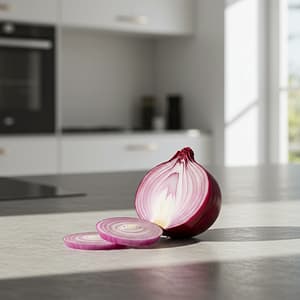- Home
- Onion

I. General Information
A. Scientific Name:
Allium cepa
B. Alternative Names:
Bulb Onion
C. Pronunciation:
uhn-yuhn
II. Sourcing and Origin
A. Source:
The bulb of a plant.
B. Geographic Origin:
Central Asia, with historical cultivation traced back over 5,000 years.
C. Method of Processing:
Raw, cooked, dehydrated flakes, powdered, or minced.
III. Properties and Uses
A. Physical Properties:
A layered, spherical, or elongated bulb with a papery outer skin. It has a pungent aroma and a sharp, sweet, or savory flavor depending on the variety and preparation.
B. Chemical Composition:
Contains sulfur compounds (responsible for its characteristic aroma and eye irritation), flavonoids, and essential oils.
C. Primary Uses:
Culinary, as a flavor enhancer and aromatic vegetable.
In Food: A foundational ingredient in many cuisines, used as a flavor base for soups, stews, curries, and stir-fries.
In Skincare/Cosmetics: Used in some products for its antioxidant properties, though less common.
In Other Products: N/A
D. Key Benefits:
Adds a rich depth of flavor and is a good source of antioxidants.
IV. Safety and Considerations
A. Potential Allergies:
Rare, but can cause contact dermatitis or allergic reactions in some people.
B. Best Practices for Use:
Store in a cool, dry, and well-ventilated area to prevent sprouting or rotting.
C. Special Precautions:
The sulfur compounds can cause eyes to water when cut.
V. Fun & Educational Facts
A. Historical Context:
In ancient Egypt, onions were revered and considered a symbol of eternal life due to their concentric rings.
B. Did You Know?
Cutting an onion releases an enzyme that converts sulfur compounds into a gas that irritates the eyes, causing tears.
C. DIY Recipe Idea:
French Onion Soup, Caramelized Onions, Onion Rings
